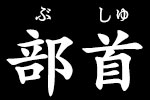🧩 What Is a Radical?

In the world of kanji, a radical or 部首 is a key building block — a visual and semantic anchor that plays a major role in both the structure and classification of kanji. Every kanji has one official radical, but its full meaning often comes from a combination of parts.
Radicals serve several roles:
- Hinting at the meaning of a kanji
- Organizing kanji by structure or theme
- Helping with kanji lookup in dictionaries
🧱 Four Types of Radicals
Linguists may or may not fully agree with classifying radicals into four types, but at Kanji World, we use this framework to better understand how radicals function:
-
 Kanji Radicals – These are full kanji that also serve as radicals — like 人 (person), 木 (tree), or 言 (speech). They can stand alone and often represent a consistent, clear concept within more complex kanji.
Kanji Radicals – These are full kanji that also serve as radicals — like 人 (person), 木 (tree), or 言 (speech). They can stand alone and often represent a consistent, clear concept within more complex kanji.
-
 Kanji Variants – Shape-altered forms of full kanji used in radical positions, such as 忄 (from 心 for emotions), 亻 (from 人 for human) or 扌 (from 手 for actions).
These preserve the original meaning in a compact form.
Kanji Variants – Shape-altered forms of full kanji used in radical positions, such as 忄 (from 心 for emotions), 亻 (from 人 for human) or 扌 (from 手 for actions).
These preserve the original meaning in a compact form.
-
 Semantic-Only Radicals – Shapes that do not appear as standalone kanji but carry specific meaning in compound characters. Examples include 艹 (plants), ⻌ (roads), 囗 (enclosure), and 疒 (illness).
Semantic-Only Radicals – Shapes that do not appear as standalone kanji but carry specific meaning in compound characters. Examples include 艹 (plants), ⻌ (roads), 囗 (enclosure), and 疒 (illness).
-
 Abstract Strokes – Simple marks like 丶, 亅, or ⼁ that don’t have semantic meaning but help organize kanji by structure or appearance.
Abstract Strokes – Simple marks like 丶, 亅, or ⼁ that don’t have semantic meaning but help organize kanji by structure or appearance.
This framework helps us see how meaning in kanji is built layer by layer — starting from full characters, moving through shape variants and semantic clues, and finally to structural tags.
📘 Radicals vs. Full Meaning: A Closer Look
Every kanji has one official radical, but its full meaning often comes from a combination of parts. To truly understand how kanji work, it helps to examine how radicals and other components interact. Below are two examples that show how meaning is layered — and why looking beyond the radical is key.
 Example 1:
Example 1:
話 (to speak)
In this case, both parts relate to speaking: 言 means “speech,” and 舌 means “tongue.” The radical is clearly semantic, and the right side adds meaning as well. Since 舌 appears on the right and is considered a weaker component, it doesn’t serve as the radical here. While 舌 can be a radical in a few specific cases, it isn’t in this one. For kanji with 言 on the left, the radical is consistently ごんべん.
 Example 2:
Example 2: 競 (to compete)
This kanji is a great example of how radicals are chosen for classification more than for meaning. All three parts — 立, 口, and 儿 — contribute to the concept of "competing," but only 立 is officially recognized as the radical.
Why? Because 立 appears in a standard radical position (top-left) and has historically been used for sorting. The other components, while meaningful and often used as radicals in other kanji, are not considered radicals in this particular case.
This highlights an important point: the official radical isn’t always the most meaningful part. To truly understand a kanji, you need to look at all its elements together.
🧠 Kanji World Insight

人 (person) is both a kanji and a radical. When it appears on the left, it often becomes 亻 (にんべん). It still means "person" or relates to human actions. This is a classic example of a kanji radical (Type 1) and its variant (Type 2).

Compare that with the radical 疒 (やまいだれ), which only appears in compound kanji and never on its own — a classic Type 3.

And finally, consider the stroke ⼁. It doesn’t mean anything by itself but helps us sort and organize kanji by form — a Type 4.
The radical system is a blend of history, meaning, and practicality. While every kanji has an official radical for classification, understanding the full meaning of a kanji means looking at all its parts.
Radicals give us insight — but they are just the starting point. Think of them as the root labels of a complex tree of meaning.